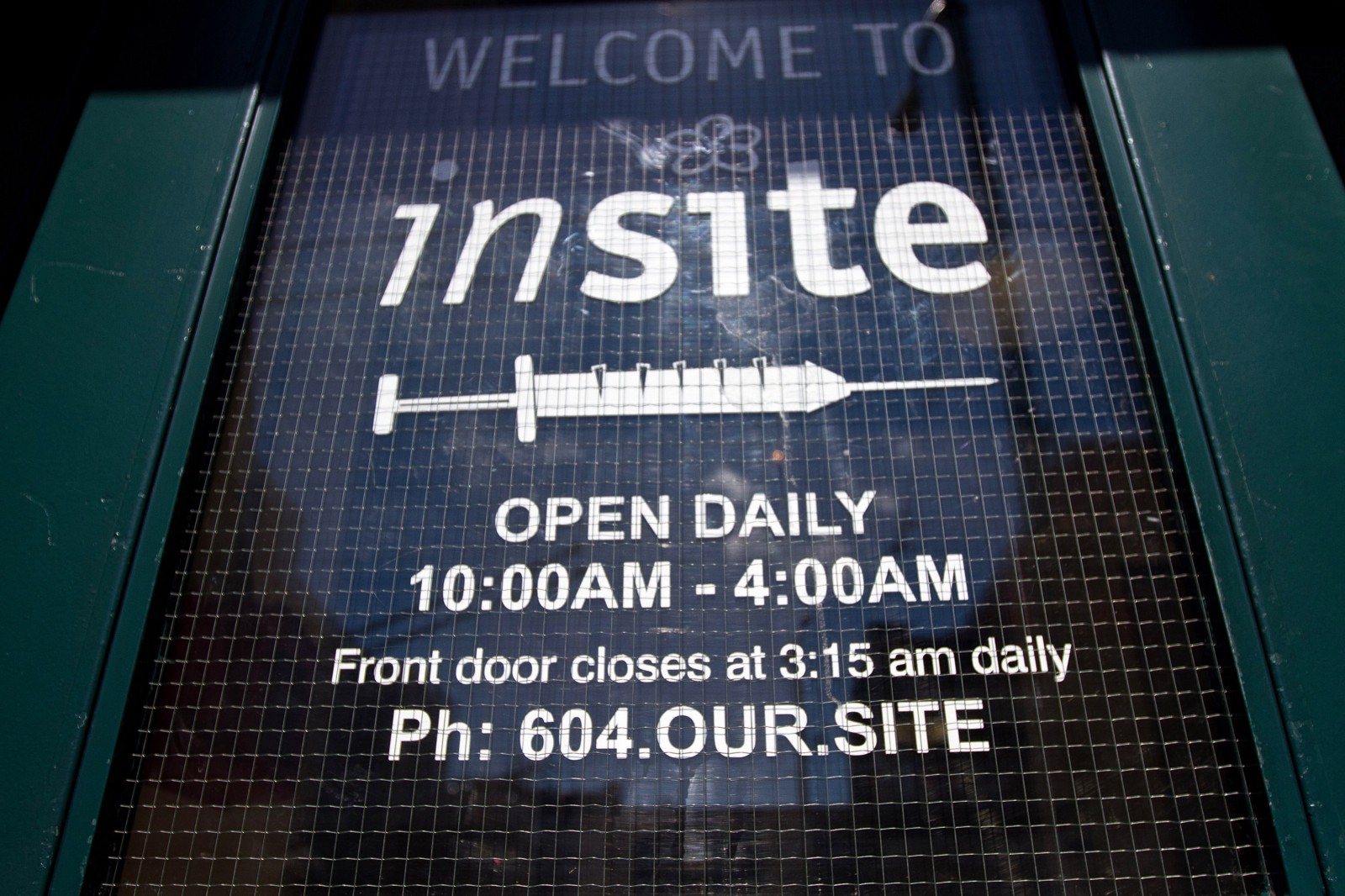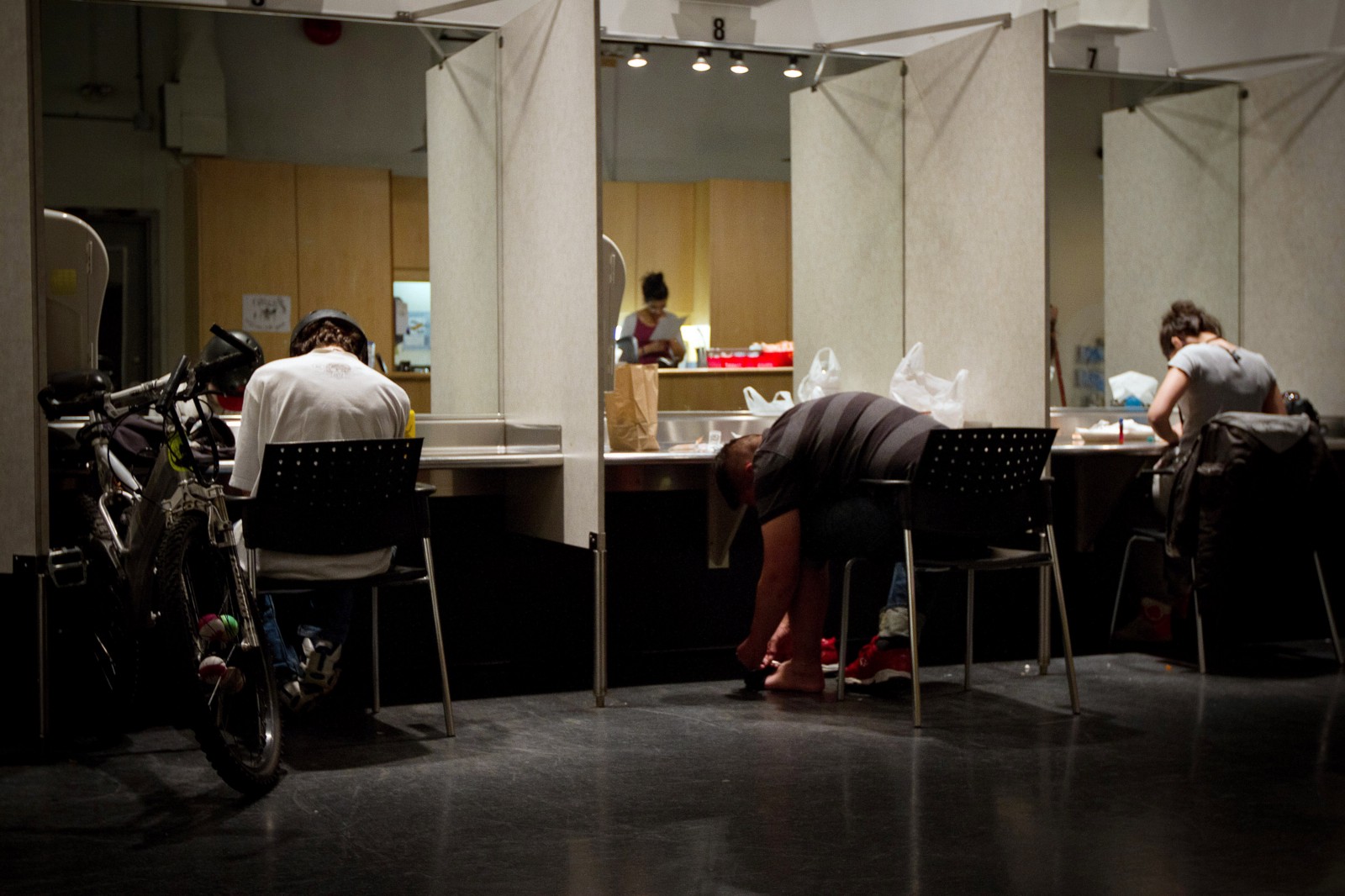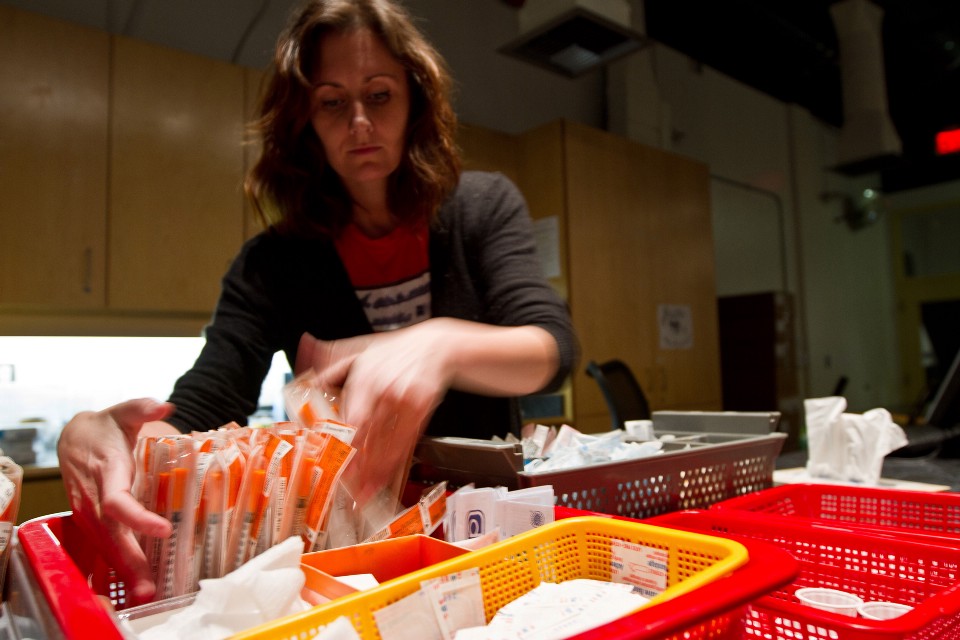Addiction, Sharon David says, can seize you any time.
Hers began in her mid-30s, after she had already navigated what many might think were the shoals of her life. She spent her adolescence on a First Nations reserve on an emerald stretch of Canada’s Long Island, off the coast of British Columbia. She lived with her grandmother, whom she says was emotionally and physically abusive. When she was 16, after a cousin’s boyfriend tried to rape her, she ran away from home. That escape eventually brought her to Vancouver’s seedy Skid Row, where she drank and sold pot, yet she didn’t use harder drugs. She didn’t like the look of those who did: “I saw a lot of people lost on it, eh?”
Social workers found her living in the streets and eventually helped her launch a decade-long career working in outreach with runaways like herself. “I did a lot of successful things in my life,” she says. “I had ferrets. I bought my very first car. I never asked my parents for anything. I used to go over and visit and give them money.”
David is 49 by the time we meet in Ovaltine, a worn diner in Vancouver’s Downtown Eastside neighborhood, where I sip coffee and she works through a pile of poutine. Like many of the women I’ll meet in the next few days I spend talking with injection-drug users in the Downtown Eastside, David is slim and delicate. At one point in our conversation, she pushes up the three-quarters-lengths sleeves of her dress to show me thick track marks on the inside of her elbows.
It was her then-boyfriend who introduced her to shooting up, she says. One day, she saw him stick a needle in his arm to inject cocaine and she asked about it. “He said, ‘You want to try it?’ I thought it’d be harmless, right? And when he did it, I fucking liked it,” she tells me. It wasn’t even the high that appealed to her so much, she doesn’t think. She liked the excitement of going out to get coke, smuggling it home, and preparing it. “The whole secrecy of it all.” Soon enough, she found herself wanting more and more.
For the next seven years, she was a “pill freak,” crushing up and injecting mostly Dilaudid and morphine, both opioid painkillers. She quit once, with the help of a methadone program she still attends. Then a sexual assault set her off again. She ended up homeless in the Downtown Eastside, shooting up seven times a day. Her nights she spent sober, awake, and wandering, terrified that if she fell asleep, somebody would assault her.
When David shifts around the hard wood booth at Ovaltine, there is a light jangle — a cacophony of keys, a lanyard, and the badge she wears for her job. Today, she is stable, mostly clean, and renting a room in the Downtown Eastside. She works part-time as a peer counselor at Insite, a government-funded supervised injection site, a clinic of sorts where injection-drug users can come to shoot up under the watchful eyes of nurses and other staff. Users must procure their own drugs—which are as illegal in Canada as they are in the United States—but staff distribute clean syringes, to help prevent the spread of viruses such as HIV and hepatitis C, and remain on hand during the injection to administer medical care in the event of an overdose.
Facilities like Insite could save thousands of people like David. And long before they gave her a job, David credits the Insite staff for saving her.

Insite is the only legally operated center of its kind in North America. It costs about $2.3 million a year to run and serves about 800 people a day, according to Russ Maynard, a member of the management team of the Portland Hotel Society, the non-profit that runs Insite and several anti-poverty projects in the Vancouver area. Insite is especially valuable to a place like Vancouver: An old estimate puts the city’s drug-injecting population at between 3,000 and 5,000.
With the drug-overdose epidemic quickly worsening—between 2000 and 2014, the rates at which Americans have died with prescription painkillers or heroin in their bloodstreams doubled—advocacy groups and politicians in Seattle, Sacramento, Boston, and Ithaca are considering opening supervised injection sites of their own. Around the world, countries including France, Germany, Norway, Spain, and Australia have opened such facilities.
But the idea has generated incredible controversy in Canada and the U.S. In a 2003 survey, 40 percent of adults living in Ontario said drug users shouldn’t have access to a supervised injection room. Canada’s Conservative Party seems to agree. In 2008, then-Prime Minister Stephen Harper’s administration announced it would no longer renew the legal exemption allowing the facility to operate. In response, Insite supporters sued. Canada’s Supreme Court ruled in 2011 that Harper had to renew the exemption.
In the U.S., even much less comprehensive overdose-reduction measures have faced stiff antagonism. In 1988, in the midst of the AIDS epidemic, Congress passed a measure forbidding federal funds from going to programs that distribute clean needles and syringes to injection-drug users, an action that’s been shown to prevent the spread of HIV. So-called needle exchanges send the wrong message and enable drug use, some claimed. Congress lifted the funding prohibition in 2009, reinstated it in 2011, and lifted it again this year.
Supporters say—and research shows—supervised injection facilities save lives and help usher some of the most underserved into rehab. People shouldn’t have to inject drugs at home alone, or huddled in a dark doorway, the reasoning goes; they should do it under lights, under the watchful eye of a seasoned staff. But opponents point out that Insite flouts drug laws and sends a message that injection drug use shouldn’t be stigmatized.
“Often you have to drag your community kicking and screaming into the light,” says Coco Culbertson, another member of the management team at the Portland Hotel Society.
The Insite staff are subscribers to the philosophy of harm reduction. Some number of people in a society will always use drugs, they say, and we need policies that reduce illness and death stemming from drug use, without requiring abstinence. This puts them squarely against the ethos of the American mainstream.
For David, it wasn’t just the service that proved to be so effective; it was the approach too. “They never, ever talked down to me. They never thought of me as a number,” she says. “They made me feel like a person, and that I was cared for even though I was lost.”

When I visit in the morning, Insite’s injection room looks large, cold, and clean. It feels like a cross between an art gallery—it has the same LED track lights along the ceiling—and a college teaching lab. There are 12 injecting booths along three of the room’s walls, each equipped with a stainless steel table surface, a plastic chair, and an enormous mirror that users face while they’re shooting up. The mirrors help staffers see what clients are doing in the booths.
Insite also features a detox center, called Onsite, right on the second floor. In the spirit of non-judgment, “fixing people isn’t an explicit policy at Insite,” Maynard says, yet they can’t keep up with the demand to “get upstairs.”
There are many people with an eye turned to Insite and similar facilities around the world. Not just addicts, but scientists, government officials, and families of users desperate for better treatment options. And the returns have been positive. “There is very good science already. These sites are quite effective,” says Thomas Kerr, co-director of the British Columbia Centre for Excellence in HIV/AIDS’s Urban Health Research Initiative, which has studied Insite extensively.

In the five years following the opening of a supervised injection site in Sydney, Australia, calls for ambulances for overdoses fell significantly in a square-mile area around the center. Similarly, in the two years after Insite opened, 35 percent fewer people died of overdoses in a three-mile radius around the clinic. For comparison, the rest of Vancouver saw overdose deaths drop by only 9 percent in that same time period.
The dramatic decline might be due, in part, to the fact that Insite not only takes care of overdoses on campus, but also offers free overdose-reversing kits and training to community members. (On the latter point, many American cities have similar initiatives.)
Steve, who lives in an abandoned lot in the Downtown Eastside, tells me he has administered overdose-reversing kits provided by Insite 49 times in the last two years. An on-again-off-again client at Insite, he has also seen staffers bring people back from overdoses inside the injection room. “I’ve sat there and seen them save a lot of lives,” he says.
There have been fewer studies about supervised injection sites’ effects on slowing the transmission of HIV, hepatitis C, and other infections. One study of Insite suggests the facility cuts down on needle sharing, which reduces the opportunities for viruses to spread. Worldwide, some studies have found that those who visit supervised injection facilities are less likely to share needles; other studies have found no difference between people who do and don’t make use of the service.
Researchers in the field say these mixed results aren’t surprising. It’s much more difficult to measure the spread of illnesses than it is to count ambulance calls or deaths. Plus, not everybody visits a supervised injection site each time they shoot up, so they may still be at risk of contracting blood-borne viruses, using in the streets. In Vancouver, folks say they sometimes pass on Insite because it’s closed, or the wait is too long. Sometimes they just don’t want to be around people. “That’s why you use drugs, right?” one woman on the street says.
Between the late 1990s and the early 2000s, the city of Vancouver slashed its hepatitis C rates by three-quarters, then by nearly half again between the early and late 2000s. Few American cities have experienced similar success with their approaches. San Francisco, which allows clean-needle programs, has seen steady hepatitis C rates for the last two decades. But it’s hard to know how much credit can be attributed to Insite because, beginning in the early 2000s, Vancouver also expanded its clean-needle programs.
One thing that is unique to supervised injection facilities is their ability to coax some of the city’s most difficult-to-reach drug users into seeing a doctor—for that infected cut, for example—or even to try detox. Insite users are 30 percent more likely to go to addiction treatment programs, one study found.
It worked for David. When she first came to Insite, she was too ashamed to tell staffers her real name. Per Insite policy, she was allowed a nickname of her choice. (“We’ve got a guy who comes in whose name’s Fucknut,” Maynard says. “My job is to call Fucknut in from the wait room. ‘Hey Fucknut, it’s your turn!’”) David chose “Smiley,” which seems apt at the time we meet. She grins big and often. When she came to use at Insite, she says, she felt that the staff cared about her. They were polite to her, which was much more than she got from police in the streets. They called her “sweetheart” and “darling.”
“Next thing you know, they started asking me: ‘Hey, are you ready for detox yet? Would you like to go upstairs?’” she recalls. “They didn’t pester me or anything. They were just being friendly and nice.”
Despite the public-health benefits—and the fact that no studies have found supervised injection sites bring more crime to an area, or encourage people to use drugs more—Insite initially faced opposition from the merchants’ associations in adjacent Gastown and Chinatown. And while both districts have since publicly supported the facility, Chinatown shop owners are strangely silent on the topic when pressed for their opinion on Insite.

(Photo: Laurent Vu/AFP/Getty Images)
Among the users I spoke with, the response to Insite was uniformly positive. “I encourage you to open them up out there,” Steve says, in reference to the U.S. We’re talking in the alley in front of his home, a few blocks from Insite. As we speak, about a dozen people prep their injections around us, shaking syringes, tourniquetting their arms, and mixing powders on little squares of foil. It’s about 5 p.m.— not even dark out yet. “There are a lot of people who oppose [supervised injection sites],” Steve adds, “but they haven’t been down here.”

Stepping onto the corner of Hastings and Carrall Streets means plunging into a swirl of activity. On this Wednesday afternoon, the block is as crowded as New York City’s SoHo neighborhood, except instead of trendy boutiques, the sidewalk is lined with makeshift shops folks have set up on folded blankets and flattened cardboard. The buyables include silk-screened T-shirts, bedazzled shorts, watches, tools, some pretty nice high-heeled shoes, and half-empty travel bottles of shampoo. The sellers lounge among their wares, smoking cigarettes and chatting with one another. Litter drifts onto one man’s display, but he doesn’t bother to move it.
A few blocks up from Carrall, there’s evidence of a more pernicious marketplace. “He’s got OxyContin,” one man mutters, while a woman strolls and calls: “Benzos! Benzos!”
There happens to be some research on Insite that suggests it has reduced what researchers call “public nuisance”—discarded needles and people using openly in the streets. To a new visitor, the site doesn’t seem to have made a material difference. A walk around the neighborhood reveals countless syringes and small, orange needle caps tucked on ledges and under the bottom edges of fences. The streets are cleaned daily, so this is just detritus from the last 24 hours.
“I just turned in about 200 rigs,” says Diane, a small woman who picks up needles for the Portland Hotel Society. I find Diane making her way up Hastings, carrying tongs and a hot yellow bucket and wearing a hot yellow safety vest to match. She volunteers because her brother contracted HIV in the 1980s, she says, dumpster diving for needles.

There’s no rule that says the sites must be run by super-progressive people, or even that they must open in areas of such extreme, concentrated need as the Downtown Eastside, although the American cities that are considering them tend already to have severe problems with people using and dying in the streets.
Some have proposed adding a few supervised injecting booths to clinics, hospitals, or anywhere people receive medical care. That might be one way to entice middle-class injection-drug users to visit. Insite does have middle-class clients, but not many, Culbertson and Maynard say. The facility is appealing to Vancouver’s homeless, but it’s unclear whether someone who might normally shoot up in his or her bedroom would go someplace like Insite. Studies have generally found people are reluctant to travel very far to visit a supervised injection facility.
Having a few booths in every clinic could expand people’s access to a service that saves lives, but Insite staffers worry that, if such facilities operate without the right philosophy, they’ll only just keep up with overdoses, if that. The staff believe that, to encourage people to use drugs less, cities need to adopt harm reduction wholesale. Non-judgment, no abstinence requirement, everything. And they need to offer concurrent social support programs, such as job placement. Insite hires promising clients, like David, to be peer counselors. “You get them housing and meaningful interactions and respect and their use goes down to a functional level,” Maynard says. “I know that sounds kind of touchy-feely, but, in practice, we see it all the time.”

(Photo: Laurent Vu/AFP/Getty Images)
It’s true that every Insite user I talk with at length—half of whom Insite staff referred me to and half of whom I found by walking around the neighborhood — credits the kindness and openness of the staff to convincing them to come to the facility at all. Instite staff “inadvertently teach people they’re worthy of love and connection,” says Donovan Mahoney, a beefy, beloved local photographer and former Insite client. In every conversation we have, David mentions how much she likes Maynard, who plied her with free lunches and coffees to coax her to work for Insite. “If I phoned him and my voice was different on the answering machine,” she says, “he’d call back immediately going, ‘Sharon, what’s wrong?’”
She does try to abstain from opioids, outside of her methadone maintenance program. (While the U.S. lags behind Canada in terms of receptivity to harm reduction, even the American federal government supports prescribing methadone and similar medicines to those with opioid use disorders.) It’s a work in progress. During one recent phone call, she admits to selling her yearly bus pass for pills. “I was dope sick,” she explains.
Once, I ask David what she wants me to know about her that I haven’t already asked. “I’m very grateful to be alive,” she says. “I don’t know how many times I could have died.” She’s just told me about how much she liked sports as a kid—she says she’s five-five, or a full five inches taller than me, and that she played basketball from when she was 10 until she quit high school. Sitting across from each other in that Ovaltine booth, however, I think we must look a little alike. We have the same narrow shoulders and arms. Her hair shines perfectly black, despite her 49 years; she says she doesn’t dye it. She says she’s had to learn to open up, because she was used to hiding her addiction in shame, but by the time we talk, she’s open and expressive, mostly grinning, but sometimes crying, furiously blinking her big eyes, which are dark, like mine.
I’m grateful she’s alive too.





